Results 11 to 20 of 32
-
06-27-2016, 06:42 AM #11

Gave the rolling x a try. Was able to get an edge on it, but after trying to shave with it, it became obvious that I didn't do a very good job. I think I'll put this in the drawer and wait awhile, like rezdog suggested.
-
06-27-2016, 07:39 AM #12
-
06-27-2016, 02:30 PM #13Senior Member




- Join Date
- Feb 2013
- Location
- Haida Gwaii, British Columbia, Canada
- Posts
- 14,443
Thanked: 4828
We can't nail everything first time and some things are best set aside. When it comes to honing the base of everything rests on the bevel set. That is the foundation on which the rest of your edge will be built on. If it is weak or incomplete it will not shave well. When it comes to getting the bevel set optics are the easiest and most reliable method of knowing that you have arrived.
It's not what you know, it's who you take fishing!
-
06-27-2016, 07:32 PM #14Senior Member



- Join Date
- Apr 2012
- Location
- Diamond Bar, CA
- Posts
- 6,553
Thanked: 3215
Sometimes setting it aside is a good idea, but from the look of the bevel ink, it is not that bad, and the rolling X stroke is a basic stoke that should be mastered, because your razor is really pretty typical for vintage razors.
I suspect, if you take your razor, ink the bevel and hone the side that is not touching the stone, then just put the index finger on the middle and hone, you will easily get the whole bevel to make contact.
I donít recommend honing a razor with that technique, because you will still have to deal with the other side.
But, If so, a rolling X stroke with the heel off the stone will get a nice even bevel, on the convex side and the rolling stroke will get the other, (concave) side.
It is a basic stroke, that would be a big arrow in your quiver. Mastering that one stroke will allow you to hone most problem razors.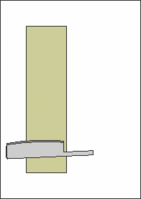
-
06-27-2016, 08:09 PM #15< Banned User >


- Join Date
- Jul 2015
- Location
- Central Oregon
- Posts
- 789
Thanked: 98
Euclid, do you ever get razors that always seem to shave better on one side than the other, that do not show any wire edge or rolling of it?
-
06-27-2016, 10:33 PM #16

Someone mentioned looking at it under magnification - and I just got a USB microscope in the mail

I looked at the bevel under the microscope, but not sure what I'm looking for. It definitely gets thinner in the middle on one side, and the heel and toe on the other.
https://youtu.be/j2G3iRDWLfM
https://youtu.be/OS9kh9gG5Qk
-
06-28-2016, 12:30 AM #17Senior Member




- Join Date
- Feb 2013
- Location
- Haida Gwaii, British Columbia, Canada
- Posts
- 14,443
Thanked: 4828
Your bevel is absolutely not set. It is way too toothy and crooked to be set. The best way to tell is to look almost straight down on the point of the apex, not the side of the bevel. The side of the bevel will show you when you have erased the stria of the previous grit and that view is valuable but not what I use for the bevel set. there are a couple of threads that show what to look for. By following those threads it will help you lot. http://straightrazorpalace.com/honin...ggestions.html
There are a couple other but this one is easy to find.It's not what you know, it's who you take fishing!
-
06-28-2016, 01:08 AM #18

Anything can be honed. Even a spoon. (Yes, it's been done).
-
06-28-2016, 09:40 AM #19

I spent most of the day reading threads, then trying to hone this thing.
I don't have a 1k stone, so I used my Norton 4k to try to set the bevel. I spent a lot of time on 4k - applying sharpie frequently to see exactly where I was removing metal.
The rolling x stroke worked well on the side where the heel and toe weren't making contact. The other side, not so much. The only way i could get the middle of the blade to make contact on that side was to physically put pressure on the middle of the blade during the stroke.
I took some pictures of the progress with my microscopes highest setting (1000x according to the box)
Before starting:
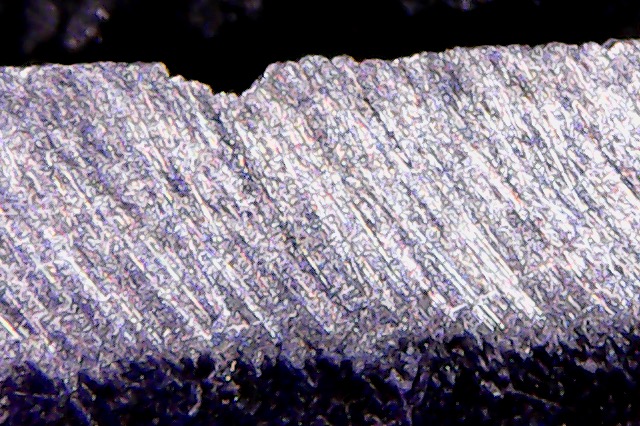
After spending time on 4k:
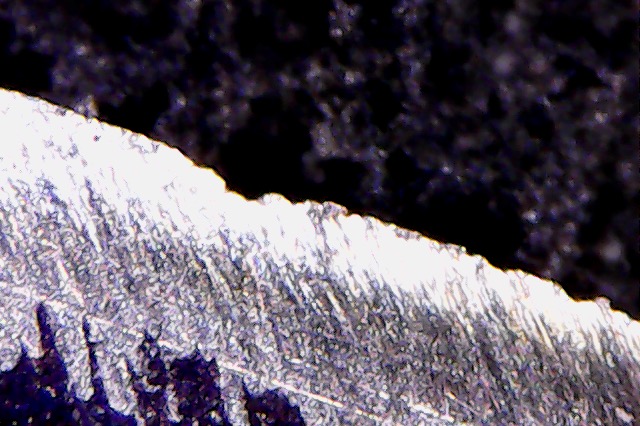
Moving up to 8k:
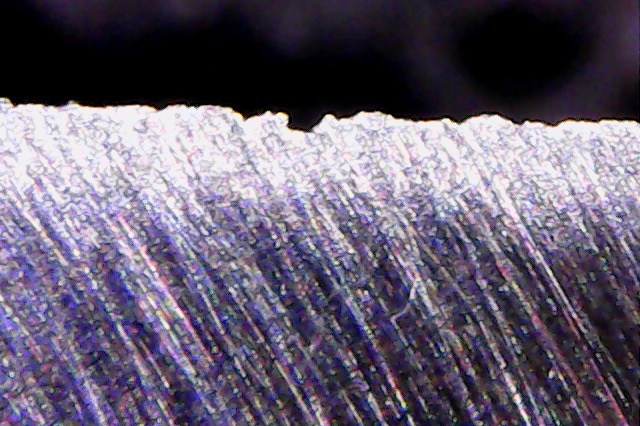
On to 12k:
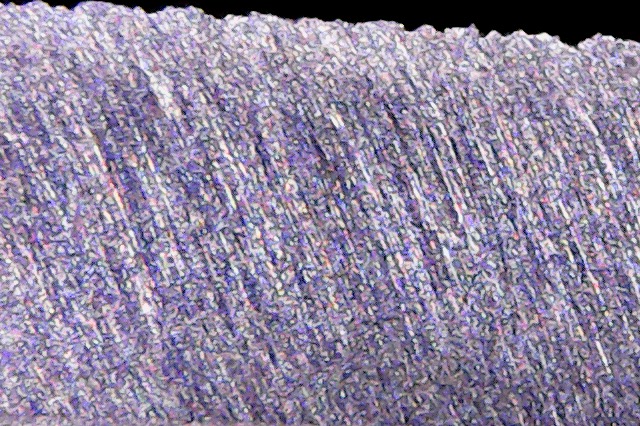
And after stropping:
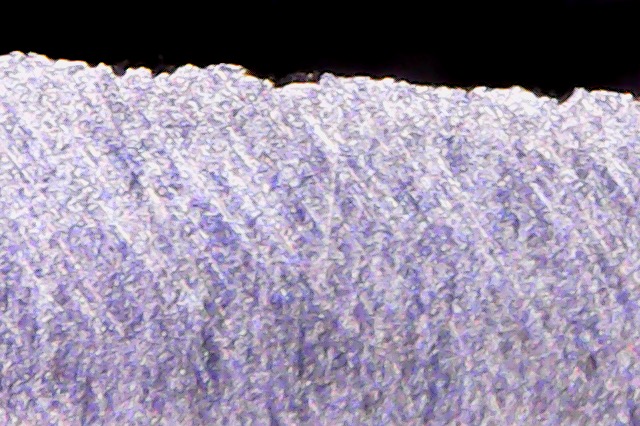
After all that, it's still not "sharp". Not HHT sharp anyway. It'll shave arm hair, but not as easily as it should.
I have a feeling it's because I couldn't get the side that had the high middle right. How do you handle getting the middle to hone when it won't make contact?
-
06-28-2016, 12:43 PM #20Senior Member



- Join Date
- Apr 2012
- Location
- Diamond Bar, CA
- Posts
- 6,553
Thanked: 3215
You can do it on a 4k just need some time and technique. A 4k is aggressive, which 4k do you have?
The razor has some issues and looks like it was rusted badly or is a cell rot victim. When you get to good steel, you will know if it continues to crumble. You also want to clean the razor, so you don’t get rust and tarnish on your strop. Steel wool, 1k wet and dry and some good metal polish.
Your razor is warped and the toe will have to be honed with the heel off the stone, to get the bevels to meet, using circles with some pressure.
But first Joint the edge straight a couple strokes on the corner of the stone. Do circles in sets of 20 until you get an edge, then move to an X stroke.
Keep jointing the edge and doing circles, until it is chip free and the bevel holds an edge. Circles are much faster at removing metal, that straight strokes. But straight strokes are easier on the edge.
You will hone the razor in 3 sections to set the bevel, toe, middle and heel, (removing steel to get the bevels to meet and to get to solid steel), then blend the bevel with X strokes on the convex side. On the Concave side a rolling X stroke will blend the bevel and straighten the edge.
Colored Ink, will save you a lot of time looking through the scope, a 60x hand held scope,60x lighted scope for a couple dollars or a Carson 60-100 Micro Max are good inexpensive hand held scopes.
Keep applying ink to check you progress and watch your tape and replace as soon as it feels sticky, start with 2 layers, you will burn through the first layer quickly.
I have heard guys say that a razor will shave better on one side than another, but I have never experienced that.
As soon as a razor begins to show a problem, I look at it with magnification, and usually see an issue that needs correcting.


 21Likes
21Likes LinkBack URL
LinkBack URL About LinkBacks
About LinkBacks






 Reply With Quote
Reply With Quote
